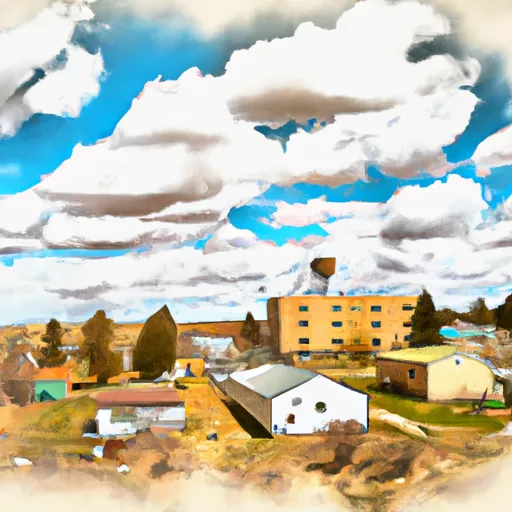-
 Snoflo Premium
Snoflo Premium
Get unlimited access to all our content
With no Ad interruptions! - Start Your Free Trial Login with existing account
Raynesford
Eden Index
Climate
7.4
•
Recreation
0.7
•
Community
•
Safeguard
3.2/10

Raynesford, Montana is a small town located in Cascade County in the northwestern United States. It experiences a semi-arid climate with cold winters and mild summers. Winters are typically snowy with temperatures dropping below freezing, while summers are warm and dry with occasional thunderstorms.
The town is surrounded by breathtaking natural beauty, including the stunning Little Belt Mountains and the Missouri River, which runs nearby. The hydrology constituents in the area include several creeks and streams that flow into the Missouri River, providing ample opportunities for fishing, boating, and water-based activities.
Raynesford is a haven for outdoor enthusiasts. The Little Belt Mountains offer rugged trails for hiking and mountain biking, giving visitors the chance to explore the picturesque landscapes and spot wildlife. Additionally, the area is renowned for its excellent hunting opportunities, with plentiful deer, elk, and upland birds.
For those seeking a slower pace, the Missouri River provides excellent fishing for trout and other species. Anglers can enjoy fly fishing or spinning for a chance to catch prized fish in the serene waters.
In conclusion, Raynesford, Montana offers a diverse climate ranging from snowy winters to dry summers, making it ideal for a range of outdoor activities. The hydrology constituents, including streams and the Missouri River, provide ample opportunities for water-based recreation. Whether it's hiking in the Little Belt Mountains or fishing in the Missouri River, Raynesford offers a wealth of options for outdoor enthusiasts to explore and appreciate the natural beauty of the region.
What is the Eden Index?
The Snoflo Eden Index serves as a comprehensive rating system for regions, evaluating their desirability through a holistic assessment of climate health, outdoor recreation opportunities, and natural disaster risk, acknowledging the profound impact of these factors on livability and well-being.
Climate Health Indicator (CHI): 7.4
Raynesford receives approximately
463mm of rain per year,
with humidity levels near 63%
and air temperatures averaging around
7°C.
Raynesford has a plant hardyness factor of
4, meaning
plants and agriculture in this region thrive during a short period during spring and early summer. Most
plants will die off during the colder winter months.
By considering the ideal temperature range, reliable water supplies, clean air, and stable seasonal rain or snowpacks, the Climate Health Indicator (CHI) underscores the significance of a healthy climate as the foundation for quality living.
A healthy climate is paramount for ensuring a high quality of life and livability in a region, fostering both physical well-being and environmental harmony. This can be characterized by ideal temperatures, reliable access to water supplies, clean air, and consistent seasonal rain or snowpacks.
Weather Forecast
Streamflow Conditions
Upper Missouri
Area Rivers
Upper Missouri
Snowpack Depths
Upper Missouri
Reservoir Storage Capacity
Upper Missouri
Groundwater Levels
Recreational Opportunity Index (ROI): 0.7
The Recreational Opportunity Index (ROI) recognizes the value of outdoor recreational options, such as parks, hiking trails, camping sites, and fishing spots, while acknowledging that climate plays a pivotal role in ensuring the comfort and consistency of these experiences.
Access to outdoor recreational opportunities, encompassing activities such as parks, hiking, camping, and fishing, is crucial for overall well-being, and the climate plays a pivotal role in enabling and enhancing these experiences, ensuring that individuals can engage in nature-based activities comfortably and consistently.
Camping Areas
| Campground | Campsites | Reservations | Toilets | Showers | Elevation |
|---|---|---|---|---|---|
| Many Pines | 23 | 6,051 ft | |||
| Thain Creek | 20 | 4,534 ft | |||
| Jumping Creek | 20 | 5,909 ft | |||
| Dry Wolf | 27 | 5,911 ft | |||
| Moose Creek | 6 | 5,814 ft | |||
| Kings Hill | 25 | 7,422 ft |
Nearby Ski Areas
Catastrophe Safeguard Index (CSI):
The Catastrophe Safeguard Index (CSI) recognizes that natural disaster risk, encompassing floods, fires, hurricanes, and tornadoes, can drastically affect safety and the overall appeal of an area.
The level of natural disaster risk in a region significantly affects safety and the overall livability, with climate change amplifying these risks by potentially increasing the frequency and intensity of events like floods, fires, hurricanes, and tornadoes, thereby posing substantial challenges to community resilience and well-being.
Community Resilience Indicator (CRI):
The Community Resilience Indicator (CRI) recognizes that education, healthcare, and socioeconomics are crucial to the well-being of a region. The CRI acknowledges the profound impact of these elements on residents' overall quality of life. By evaluating educational resources, healthcare accessibility, and economic inclusivity, the index captures the essential aspects that contribute to a thriving community, fostering resident satisfaction, equity, and social cohesion.

